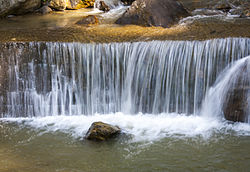
Sikkim is a state in northeastern India. It borders the Tibet Autonomous Region of China in the north and northeast, Bhutan in the east, Koshi Province of Nepal in the west, and West Bengal in the south. Sikkim is also close to the Siliguri Corridor, which borders Bangladesh. Sikkim is the least populous and second smallest among the Indian states. Situated in the Eastern Himalaya, Sikkim is notable for its biodiversity, including alpine and subtropical climates, as well as being a host to Kangchenjunga, the highest peak in India and third highest on Earth. Sikkim's capital and largest city is Gangtok. Almost 35% of the state is covered by Khangchendzonga National Park – a UNESCO World Heritage Site.
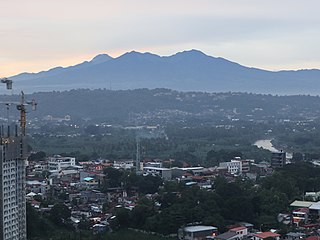
Mount Apo, also known locally as Apo Sandawa, is a large solfataric, dormant stratovolcano on the island of Mindanao, Philippines. With an elevation of 2,954 meters (9,692 ft) above sea level, it is the highest-mountain in the Philippine Archipelago, Mindanao and 24th-highest peak of an island on Earth. Located on the tripartite border of Davao City and Davao del Sur in the Davao Region, and Cotabato in Soccsksargen, Mount Apo is the most-prominent mountain in the Philippines. The peak overlooks from Davao City 45 kilometers (28 mi) to the northeast, Digos 25 kilometers (16 mi) to the southeast, and Kidapawan 20 kilometers (12 mi) to the west. It is a protected area and a Natural Park of the Philippines.
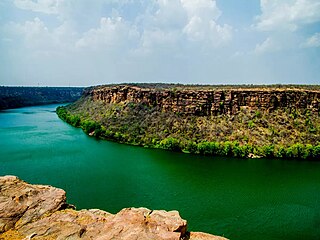
Tourism in India is 4.6% of the country's gross domestic product (GDP). Unlike other sectors, tourism is not a priority sector for Government of India. Forbes magazine ranked India as the 7th most beautiful country in 'The 50 Most Beautiful Countries In The World' rankings. The World Travel and Tourism Council calculated that tourism generated ₹13.2 lakh crore (US$170 billion) or 5.8% of India's GDP and supported 32.1 million jobs in 2021. Even though, these numbers were lower than the pre-pandemic figures; the country's economy witnessed a significant growth in 2021 after the massive downturn during 2020. The sector is predicted to grow at an annual rate of 7.8% to ₹33.8 lakh crore (US$420 billion) by 2031. India has established itself as the 5th largest global travel healthcare destination with an estimated market size of around $9 billion in 2019, out of the total global travel healthcare industry of $44.8 billion(2019). In 2014, 184,298 foreign patients travelled to India to seek medical treatment.

Gangtok is a city, municipality, the capital and the most populous city of the Indian state of Sikkim and also the headquarters of Gangtok District. Gangtok is in the eastern Himalayan range, at an elevation of 1,650 m (5,410 ft). The city's population of 100,000 consists of the three Sikkimese ethnicities the Bhutias, Lepchas, Gorkhalis and also plainsmen from other states of India have settled here. Within the higher peaks of the Himalayas and with a year-round mild temperate climate, Gangtok is at the centre of Sikkim's tourism industry.

Pelling is a hill station in Gyalshing district of Sikkim, India. Pelling is nestled at an altitude of 2,150 m (7,200 feet). The town is located at a distance of 10 km from Gyalshing city, the district headquarters and 131 km from Gangtok. A regular bus service connects the two towns. However, with the influx of tourists, the region is undergoing a metamorphosis, with the roads being repaired and hotels being set up.
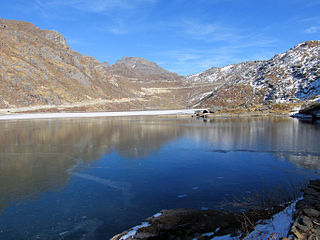
Gangtok District, is an administrative district of the Indian state of Sikkim. It was renamed in 2021 as a result of administrative reorganisation of the state, which also saw three subdivisions of the East Sikkim district spawned off as a separate Pakyong district.

Kodaikanal is a hill station which is located in Dindigul district in the state of Tamil Nadu, India. Its name in the Tamil language means "The Gift of the Forest". Kodaikanal is referred to as the "Princess of Hills" and has a long history as a retreat and tourist destination.

Tsomgo Lake, also known as Tsongmo Lake or Changgu Lake, is a glacial lake in the East Sikkim district of the Indian state of Sikkim, some 40 kilometres (25 mi) from the capital Gangtok. Located at an elevation of 3,753 m (12,313 ft), the lake remains frozen during the winter season. The lake surface reflects different colours with change of seasons and is held in great reverence by the local Sikkimese people. Buddhist monks prognosticated after studying the changing colours of the lake.

Yuksom is a historical town in Geyzing subdivision of West Sikkim district in the Northeast Indian state of Sikkim. It was the first capital of Kingdom of Sikkim established in 1642 AD by Phuntsog Namgyal who was the first Chogyal of Sikkim. The coronation site of the first monarch of Sikkim is known as the "Throne of Norbugang". Yuksom is where there is the Norbugang Chorten near the Norbugang throne, the place Namgyal was crowned and several monasteries and a lake. The dynastic rule of the Chogyals lasted for 333 years.
Aritar is a region in the Pakyong District under Rongli Sub-Division of the Indian state of Sikkim.
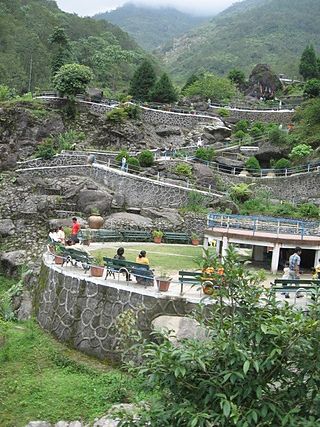
The Rock Garden at Chunnu Summer Falls and Ganga Maya Park are recently added tourist attractions in the hilly town of Darjeeling in the state of West Bengal, India. It is a showpiece meant to lure people to Darjeeling after political agitations disrupted tourism in the 1980s. There is another rock garden in Darjeeling known as Sir John Anderson Rock Garden, which is part of Lloyd's Botanical Garden.

Rabong or Ravangla is a small tourist town with an elevation of 8000 feet located, near Namchi City in the Namchi district of the Indian state of Sikkim. It is connected by state highway to other major towns in the state and lies between Namchi, Pelling and Gangtok. It is the starting point for the trek to Maenam Wildlife Sanctuary. It is approximately 65 km from the state capital, Gangtok, and 120 km from Siliguri, West Bengal. The name is derived from the Sikkimese language. ‘Ra’ means wild sheep, 'vong' translates to a rearing place, and ‘la’ means a pass.
Tourism in Odisha is one of the main contributors to the economy of Odisha, India, with a 500 km (310 mi) long coastline, mountains, lakes, natural biodiversity and rivers. Odisha is a major tourist destination in India, with various tourist attractions, including wildlife reserves, beaches, temples, monuments, the arts and festivals. Other than wildlife reserves, beaches, temples, monuments, the arts and festivals, the Odisha Tourism Development Corporation, a public sector undertaking of the Government of Odisha, is also developing the tourism sector of Odisha and India.

Rhenock is a town in the Pakyong District in Sikkim, India, located on the border with the Kalimpong district of West Bengal. It lies 63 kilometres east of Gangtok, and 47 kilometres north of Kalimpong on the way to Jelepla Pass at an altitude of 1,040 metres. The word Rhe-nock means Black Hill. Situated in the extreme east of Sikkim, Rhenock witnessed the establishment of the first police outpost in the state.
Labrang Monastery (Sikkim), Palden Phuntshog Phodrang or Palden Phuntsok Monastery is a Buddhist monastery located in North Sikkim district in Sikkim, northeastern India.

Jhākri is the Nepali word for shaman or diviner. It is sometimes reserved specifically for practitioners of Nepali shamanism, such as that practiced among the Tamang people and the Magars; it is also used in the Indian states of Sikkim and West Bengal, which border Nepal. The practice of using a Jhaakri as a channel or medium by a Hindu god or goddess to give solutions or answers to the questions of devotees is known as, "dhaamee " in Nepali.

The Buddha Park of Ravangla, also known as Tathagata Tsal, is situated near Ravangla in South Sikkim district of the Indian state of Sikkim. It was constructed between 2006 and 2013, and features a 130-foot-high (40 m) statue of the Buddha, erected to mark the 2550th anniversary of the birth of Gautama Buddha, as its main attraction. The statue, built of 60 tonnes of copper, is an example of repousse work. Mount Narsing forms the backdrop to the statue. The site was chosen within the larger religious complex of Rabong Monastery, itself a centuries-old place of pilgrimage. Also nearby is Ralang Monastery, a key monastery in Tibetan Buddhism. Built and installed through the joint efforts of the government and people of Sikkim, the statue was consecrated on 25 March 2013 by the 14th Dalai Lama. The Buddhist circuit of the park was built under a state government project, intended to boost pilgrimage and tourism to the region. The Cho Djo lake is located within the complex, surrounded by forest. The park has a tranquil setting with spacious pathways, and there is a Buddhist conclave, a meditation centre and a museum with a spiral gallery.
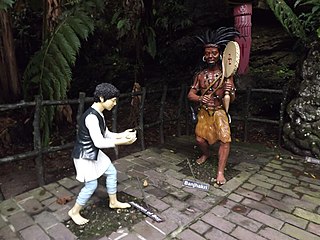
Banjhākri and Banjhākrini are shamanic deities in the tradition of the Kirati people of Nepal and Sikkim, Darjeeling, and Kalimpong in India. They are a couple, and possibly different aspects of the same being. They are supernatural shamans of the forest. In the Nepali language, ban means "wilderness", jhākri means "shaman", and jhākrini means "shamaness". Banjhākrini is also known as Lemlemey.

Northeast India consists of the eight states Arunachal Pradesh, Assam, Manipur, Meghalaya, Mizoram, Nagaland, Sikkim and Tripura. Tourism in this area is based around the unique Himalayan landscape and culture distinct from the rest of India.

Tourism in India is economically important and ever-growing. The World Travel & Tourism Council calculated that tourism generated ₹14.02 lakh crore (US$180 billion) or 9.6% of the nation's GDP in 2016 and supported 40.343 million jobs, 9.3% of its total employment. The sector is predicted to grow at an annual rate of 6.8% to ₹28.49 lakh crore (US$360 billion) by 2027. Various states and union territories of India attract tourists from all over the world, mainly due to the cultural diversity.
